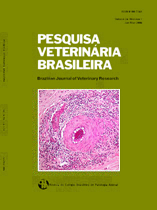 |
|
|
|
Year 2012 - Volume 32, Number 6
|

|
Acute abdomen in equidae in the semiarid of the Brazilian Northeast, 32(6):503-509
|
ABSTRACT.- Pessoa A.F.A, Miranda Neto E.G., Pessoa C.R.M., Simões S.V.D., Azevedo S.S. & Riet-Correa F. 2012. [Acute abdomen in equidae in the semiarid of the Brazilian Northeast.] Abdômen agudo em equídeos no semiárido do Nordeste do Brasil. Pesquisa Veterinária Brasileira 32(6):503-509. Hospital Veterinário, Centro de Saúde e Tecnologia Rural, Campus de Patos, Universidade Federal de Campina Grande, Patos, PB 58700-070, Brazil. E-mail: franklin.riet@pq.cnpq.br
The cases of equidae acute abdomen diagnosed in the Veterinary Hospital of the Federal University of Campina Grande, in the semiarid of the Brazilian Northeast were reviewed. From January 2001 to December 2011, 70 (4.5%) equidae out of 1542 were affected by colic, including 60 horses, 4 mules, and 6 donkeys. Large colon impaction diagnosed in 37.14% of the cases was the most frequent cause of colic, followed by small colon impaction (10%) and foreign body in the small colon (7.14%). In four cases, colics were caused by phytobezoars in the large gut, two of which were associated with the ingestion of large amounts of fresh Prosopis juliflora pods. Six cases of colic by foreign bodies, mainly plastic bags, were observed, five located in the small colon and one in the large colon. Strangulating small intestinal lesions were observed in four cases. Other causes of colic were spasmodic colic (two cases due to gastrointestinal parasites and two due to consumption of home residues), and gastric impaction (three cases). Large colon displacement was diagnosed twice. Laceration of the small colon, cecal torsion, and bloat by ingestion of Manihot esculenta were diagnosed once. The main risk factor for the occurrence of colic was the ingestion of choped Pennisetum purpureum, Brachiaria spp., Sorghum spp. or Echinochloa polystachya (OR=4.03; P=0.007). As a result of the low quality of the foods the frequency of colic was significantly higher during the dry season (second semester) (OR=2.61; P<0.01). It is concluded that feeding with low quality forages during the dry season contributes with the high frequency of cases of colic in the Brazilian semiarid, and that is necessary to improve food quality and food management to try to decrease the frequency of this syndrome in the region. |
| |
|
|
| |
|
 |